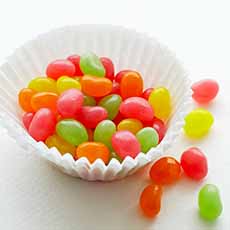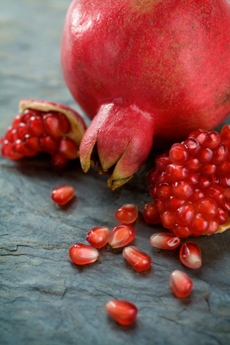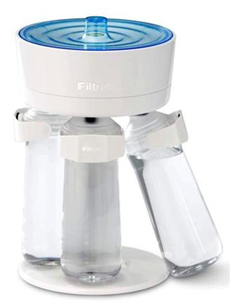|

[1] Jelly beans are mostly sugar. No wonder they are so popular! (photo by River Soma | © THE NIBBLE).

[2] Today, jelly beans are associated with kids’ Easter candy. But they’re fun year-round; and were President Ronald Regan’s favorite candy (photo © Williams Sonoma).

[3] Jelly beans became associated with Easter because of their egg-like shape (photo © Jelly Belly).
|
|
Today is National Jelly Bean Day. It’s also the 35th anniversary of the best-known brand of jelly beans, Jelly Belly, which petitioned for the holiday.
So let’s check out the history of jelly beans!
THE BEGINNINGS OF JELLY BEAN HISTORY
Many sugared confections are the ancestors of jelly beans.
Turkish Delight, which is jelled sugar and rosewater coated with powdered sugar, is one well-known candy that, accordg to Candy Warehouse, is mentioned in the Bible (see the photo for the resemblance to jelly beans).
Centuries later, an unknown confectioner switched the powdered sugar for granulated sugar, added some flavors, and created the gumdrop.
Then, in the 17th century, a French confectioner invented a process called panning, which created a hard sugar coating by stirring candies in a mixture of sugar and syrup.
Nuts were panned (such as Jordan almonds); later, chocolate was used to create chocolate-covered nuts and other candies.
Take a gooey mixture called a sugar slurry, add a coating and you get a jelly bean.
Jelly beans are made from sugar, corn syrup and starch, with small amounts of anti-foaming agent, flavoring, lecithin and salt.
To make them shiny, they’re coated with edible wax and confectioners’ glaze.
MODERN JELLY BEAN HISTORY
The modern jelly bean is believed to have been invented in the U.S., sometime after 1850.
The earliest recorded advertisement for jelly beans is from Boston confectioner William Schrafft, who may have also been the creator.* The ad promoted sending jelly beans to Union Soldiers engaged in the Civil War (1861-1865).
By the early 1900s, jelly beans had become a staple penny candy. Possibly, they were the first bulk candy.
Jelly beans became part of the Easter tradition in the 1930s, when somebody connected their egg shape with the eggs symbolic of the spiritual rebirth of Easter. Their festive colors made them a perfect celebratory candy.
During World War II, much of the chocolate produced in the U.S. was sent overseas to soldiers. Americans focused on other sweets; flavorful, colorful jelly beans became popular.
And, if you’re old enough to remember, they were the favorite candy of president Ronald Regan.
He persuaded the Jelly Belly company to make a blueberry jelly bean so that he could serve red, white and blue jelly beans in the Oval Office.
|
|
JELLY BEAN TRIVIA†
Here’s some jelly bean trivia:
Americans will eat some 15 billion jelly beans over the Easter holiday.
Boys are more likely to eat a handful at a time while girls eat them one by one.
Given an assortment, most people eat them in this order: red, purple, green, yellow and black.
Happy National Jelly Bean Day!
____________________
*Schraft’s candy company was established in Charlestown, Massachusetts in 1861, by William F. Schrafft. Succeeding him in 1898, Frank Shattuck expanded the company to include restaurants, most located in Manhattan. The ice candy and cream sundaes were very popular when Pet, Inc., makers of Pet evaporated milk, purchased Schrafft’s in 1967. They broke the ice cream, restaurant, and candy operations into separate companies. Alas, it is no longer in businesses.
†From CandyWarehouse.com.
|





